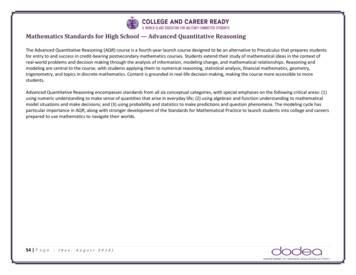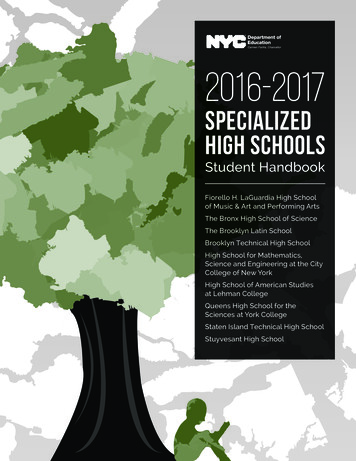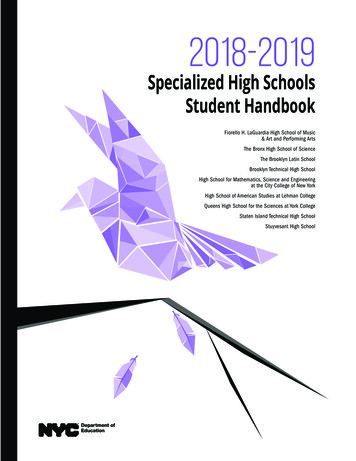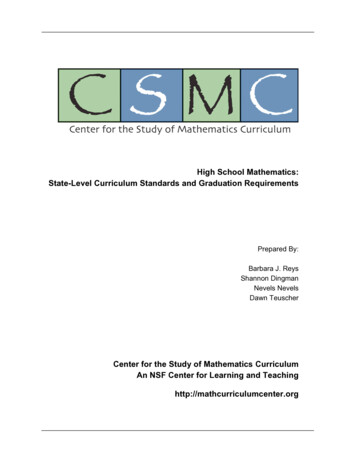
Transcription
Mathematics Standards for High School — Advanced Quantitative ReasoningThe Advanced Quantitative Reasoning (AQR) course is a fourth-year launch course designed to be an alternative to Precalculus that prepares studentsfor entry to and success in credit-bearing postsecondary mathematics courses. Students extend their study of mathematical ideas in the context ofreal-world problems and decision making through the analysis of information, modeling change, and mathematical relationships. Reasoning andmodeling are central to the course, with students applying them to numerical reasoning, statistical analysis, financial mathematics, geometry,trigonometry, and topics in discrete mathematics. Content is grounded in real-life decision making, making the course more accessible to morestudents.Advanced Quantitative Reasoning encompasses standards from all six conceptual categories, with special emphases on the following critical areas: (1)using numeric understanding to make sense of quantities that arise in everyday life; (2) using algebraic and function understanding to mathematicalmodel situations and make decisions; and (3) using probability and statistics to make predictions and question phenomena. The modeling cycle hasparticular importance in AQR, along with stronger development of the Standards for Mathematical Practice to launch students into college and careersprepared to use mathematics to navigate their worlds.54 P a g e - ( R e v . A u g u s t 2 0 1 8 )
Advanced Quantitative Reasoning Overview – Conceptual Categories, Domains, and ClustersNumber and QuantityFunctionsQuantitiesA. Reason quantitatively and use units to solveproblemsVector and Matrix QuantitiesB. Perform operations on vectorsC. Perform operations on matrices and use matricesin applicationsInterpreting FunctionsB. Interpret functions that arise in applications interms of the contextC. Analyze functions using different representationsLinear, Quadratic, and Exponential ModelsA. Construct and compare linear, quadratic, andexponential models and solve problemsTrigonometric FunctionsB. Model periodic phenomena with trigonometricfunctionsAlgebraCreating EquationsA. Create equations that describe numbers orrelationshipsGeometrySimilarity, Right Triangles, and TrigonometryB. Prove theorems involving similarityC. Define trigonometric ratios and solve problemsinvolving right trianglesD. Apply trigonometry to general trianglesModeling with GeometryA. Define trigonometric ratios and solve problemsinvolving right triangles55 P a g e - ( R e v . A u g u s t 2 0 1 8 )Statistics and ProbabilityInterpreting Categorical and Quantitative DataA. Summarize, represent, and interpret data on asingle count or measurement variableB. Summarize, represent, and interpret data on twocategorical and quantitative variablesC. Interpret linear modelsMaking Inferences and Justifying ConclusionsA. Understand and evaluate random processesunderlying statistical experimentsB. Make inferences and justify conclusions fromsample surveys, experiments, and observationalstudiesConditional Probability and the Rules of ProbabilityB. Use the rules of probability to computeprobabilities of compound events in a uniformprobability modelUsing probability to evaluate outcomes and decisionsA. Calculate expected values and use them to solveproblemsB. Use probability to evaluate outcomes of decisionsSTANDARDS FORMATHEMATICALPRACTICE1. Make sense ofproblems andpersevere in solvingthem.2. Reason abstractlyand quantitatively.3. Construct viablearguments andcritique thereasoning of others.4. Model withmathematics.5. Use appropriatetools strategically.6. Attend to precision.7. Look for and makeuse of structure.8. Look for and expressregularity inrepeated reasoning.
Number and QuantityQuantities A. Reason quantitatively and use units to solve problems.1. Use units as a way to understand problems and to guide the solution of multi-step problems; choose and interpret units consistentlyin formulas; choose and interpret the scale and the origin in graphs and data displays.2. Define appropriate quantities for the purpose of descriptive modeling.3. Choose a level of accuracy appropriate to limitations on measurement when reporting quantities.Vector and Matrix QuantitiesC. Perform operations on matrices and use matrices in applications.6. ( ) Use matrices to represent and manipulate data, e.g., to represent payoffs or incidence relationships in a network.7. ( ) Multiply matrices by scalars to produce new matrices, e.g., as when all of the payoffs in a game are doubled.8. ( ) Add, subtract, and multiply matrices of appropriate dimensions.9. ( ) Understand that, unlike multiplication of numbers, matrix multiplication for square matrices is not a commutative operation, butstill satisfies the associative and distributive properties.10. ( ) Understand that the zero and identity matrices play a role in matrix addition and multiplication similar to the role of 0 and 1 in thereal numbers. The determinant of a square matrix is nonzero if and only if the matrix has a multiplicative inverse.11. ( ) Multiply a vector (regarded as a matrix with one column) by a matrix of suitable dimensions to produce another vector. Work withmatrices as transformations of vectors.12. ( ) Work with 2 2 matrices as transformations of the plane, and interpret the absolute value of the determinant in terms of area.N—QN—VMAlgebraCreating Equations A. Create equations that describe numbers or relationships1. Create equations and inequalities in one variable and use them to solve problems. Include equations arising from linear andquadratic functions, and simple rational and exponential functions.2. Create equations in two or more variables to represent relationships between quantities; graph equations on coordinate axes withlabels and scales.A—CEDFunctionsInterpreting FunctionsB. Interpret functions that arise in applications in terms of the context4. For a function that models a relationship between two quantities, interpret key features of graphs and tables in terms of thequantities, and sketch graphs showing key features given a verbal description of the relationship. Key features include: intercepts;56 P a g e - ( R e v . A u g u s t 2 0 1 8 )F—IF
intervals where the function is increasing, decreasing, positive, or negative; relative maximums and minimums; symmetries; endbehavior; and periodicity. C. Analyze functions using different representations7. Graph functions expressed symbolically and show key features of the graph, by hand in simple cases and using technology for morecomplicated cases. b. Graph square root, cube root, and piecewise-defined functions, including step functions and absolute value functions.e. Graph exponential and logarithmic functions, showing intercepts and end behavior, and trigonometric functions, showing period,midline, and amplitude.Linear, Quadratic, and Exponential Models A. Construct and compare linear, quadratic, and exponential models and solve problems1. Distinguish between situations that can be modeled with linear functions and with exponential functions.c. Recognize situations in which a quantity grows or decays by a constant percent rate per unit interval relative to another.2. Construct linear and exponential functions, including arithmetic and geometric sequences, given a graph, a description of arelationship, or two input-output pairs (include reading these from a table).4. For exponential models, express as a logarithm the solution to abct d where a, c, and d are numbers and the base b is 2, 10, or e;evaluate the logarithm using technology.Trigonometric FunctionsB. Model periodic phenomena with trigonometric functions5. Choose trigonometric functions to model periodic phenomena with specified amplitude, frequency, and midline. F—LEF—TFGeometrySimilarity, Right Triangles, and TrigonometryB. Prove theorems involving similarity5. Use congruence and similarity criteria for triangles to solve problems and to prove relationships in geometric figures.C. Define trigonometric ratios and solve problems involving right triangles8. Use trigonometric ratios and the Pythagorean Theorem to solve right triangles in applied problems. D. Apply trigonometry to general triangles10. ( ) Prove the Laws of Sines and Cosines and use them to solve problems.11. ( ) Understand and apply the Law of Sines and the Law of Cosines to find unknown measurements in right and non-right triangles(e.g., surveying problems, resultant forces).Geometric Measurement and DimensionA. Explain volume formulas and use them to solve problems2. ( ) Give an informal argument using Cavalieri’s principle for the formulas for the volume of a sphere and other solid figures.3. Use volume formulas for cylinders, pyramids, cones, and spheres to solve problems. 57 P a g e - ( R e v . A u g u s t 2 0 1 8 )G—SRTG—GMD
Modeling with GeometryA. Apply geometric concepts in modeling situations3. Apply geometric methods to solve design problems (e.g., designing an object or structure to satisfy physical constraints orminimize cost; working with typographic grid systems based on ratios). G—MGStatistics and Probability Interpreting Categorical and Quantitative DataA. Summarize, represent, and interpret data on a single count or measurement variable2. Use statistics appropriate to the shape of the data distribution to compare center (median, mean) and spread (interquartile range,standard deviation) of two or more different data sets.3. Interpret differences in shape, center, and spread in the context of the data sets, accounting for possible effects of extreme datapoints (outliers).B. Summarize, represent, and interpret data on two categorical and quantitative variables6. Represent data on two quantitative variables on a scatter plot, and describe how the variables are related.a. Fit a function to the data; use functions fitted to data to solve problems in the context of the data. Use given functions orchoose a function suggested by the context. Emphasize linear, quadratic, and exponential models.b. Informally assess the fit of a function by plotting and analyzing residuals.c. Fit a linear function for a scatter plot that suggests a linear association.D. Interpret linear models8. Compute (using technology) and interpret the correlation coefficient of a linear fit.9. Distinguish between correlation and causation.Making Inferences and Justifying ConclusionsA. Understand and evaluate random processes underlying statistical experiments2. Decide if a specified model is consistent with results from a given data-generating process, e.g., using simulation. For example, amodel says a spinning coin falls heads up with probability 0.5. Would a result of 5 tails in a row cause you to question the model?B. Make inferences and justify conclusions from sample surveys, experiments, and observational studies4. Use data from a sample survey to estimate a population mean or proportion; develop a margin of error through the use ofsimulation models for random sampling.6. Evaluate reports based on data.Conditional Probability and the Rules of ProbabilityA. Understand independence and conditional probability and use them to interpret data4. Construct and interpret two-way frequency tables of data when two categories are associated with each object being classified.Use the two-way table as a sample space to decide if events are independent and to approximate conditional probabilities. Forexample, collect data from a random sample of students in your school on their favorite subject among math, science, and English.58 P a g e - ( R e v . A u g u s t 2 0 1 8 )S—IDS—ICS—CP
Estimate the probability that a randomly selected student from your school will favor science given that the student is in tenthgrade. Do the same for other subjects and compare the results.B. Use the rules of probability to compute probabilities of compound events in a uniform probability model6. Find the conditional probability of A given B as the fraction of B’s outcomes that also belong to A, and interpret the answer interms of the model.7. Apply the Addition Rule, P(A or B) P(A) P(B) – P(A and B), and interpret the answer in terms of the model.8. ( ) Apply the general Multiplication Rule in a uniform probability model, P(A and B) P(A)P(B A) P(B)P(A B), and interpret theanswer in terms of the model.9. ( ) Use permutations and combinations to compute probabilities of compound events and solve problems.Using Probability to Make DecisionsA. Calculate expected values and use them to solve problems1. ( ) Define a random variable for a quantity of interest by assigning a numerical value to each event in a sample space; graph thecorresponding probability distribution using the same graphical displays as for data distributions.2. ( ) Calculate the expected value of a random variable; interpret it as the mean of the probability distribution.B. Use probability to evaluate outcomes of decisions5. ( ) Weigh the possible outcomes of a decision by assigning probabilities to payoff values and finding expected values.a. Find the expected payoff for a game of chance. For example, find the expected winnings from a state lottery ticket or a gameat a fast food restaurant.b. Evaluate and compare strategies on the basis of expected values. For example, compare a high-deductible versus a lowdeductible automobile insurance policy using various, but reasonable, chances of having a minor or a major accident.6. ( ) Use probabilities to make fair decisions (e.g., drawing by lots, using a random number generator).7. ( ) Analyze decisions and strategies using probability concepts (e.g., product testing, medical testing, pulling a hockey goalie at theend of a game).59 P a g e - ( R e v . A u g u s t 2 0 1 8 )S—MD
Mathematics Standards for High School — Advanced Quantitative Reasoning The Advanced Quantitative Reasoning (AQR) course is a fourth-year launch course designed to be an alternative to Precalculus that prepares students for entry to and success in credit-bearing postsecondary mathematics courses. Student










